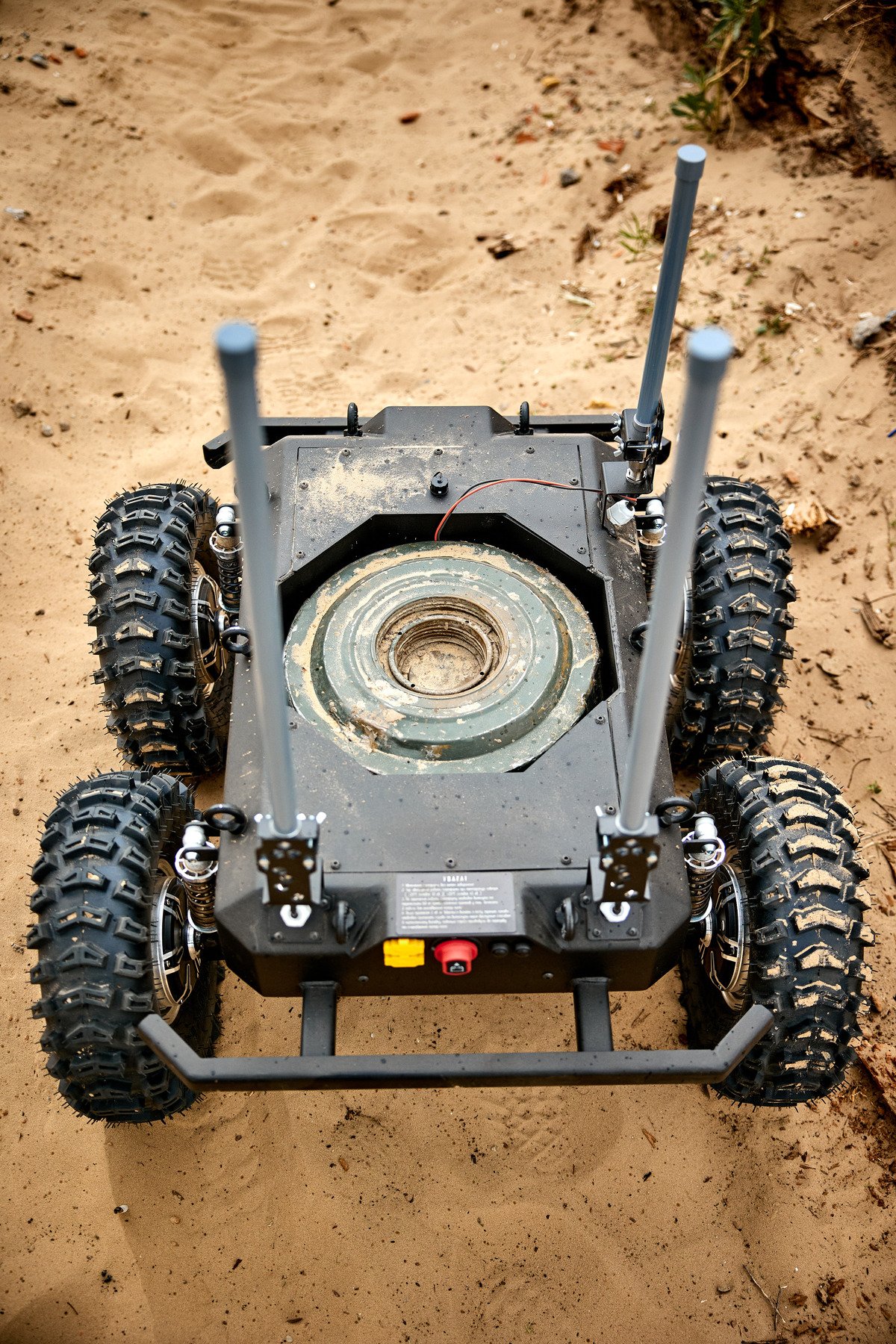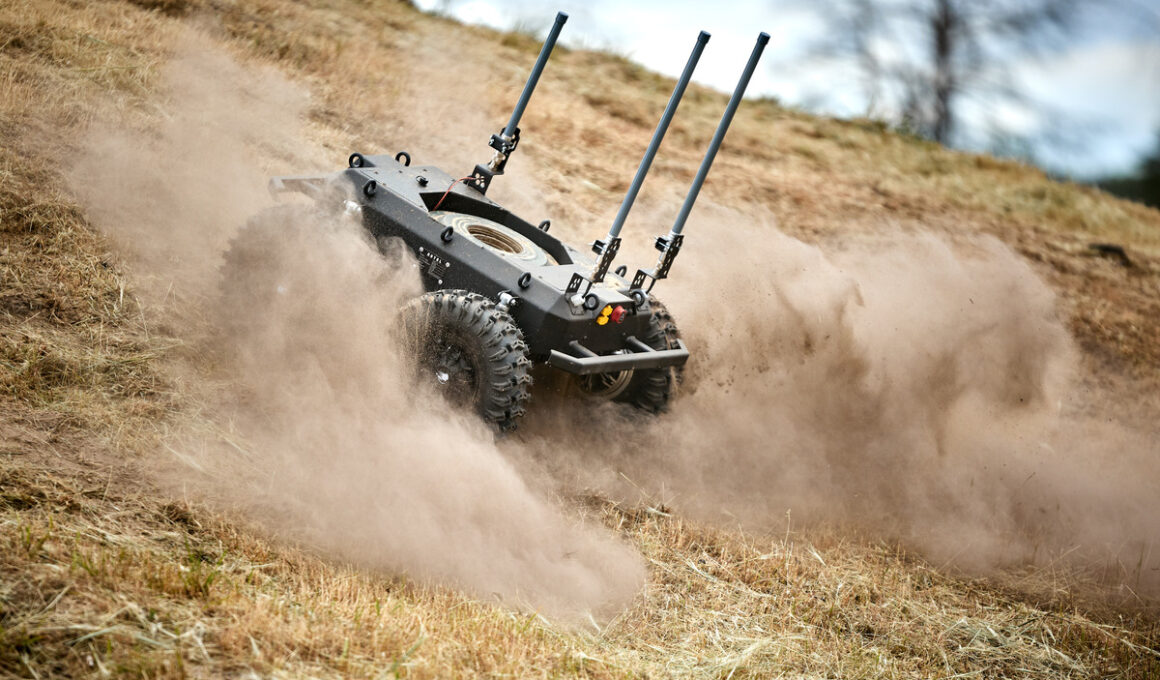Ukraine’s skies are cluttered with airborne drones, and developers and operators are looking elsewhere to beat out Russia in the drone race that has dominated the nearly two-and-a-half years of war in the country.
Kyiv is cultivating new ground drone fleets, which it hopes can give Ukrainian troops an edge over a more vast, better-resourced Russian Army by overcoming widespread and increasingly problematic jamming, Ukrainian personnel involved in the push for unmanned ground vehicles told Newsweek.
It is very difficult to jam a land robot, also known as unmanned ground vehicles (UGVs) or ground drones, said Ruslan, a Ukrainian military expert who was among the first of Kyiv’s operators to use the domestically-produced Ratel-S ground drone on the battlefield. Ruslan declined to give his surname for security reasons.
The world has looked on avidly at the battlefields of Ukraine, monitoring the rapid evolution of drone technology dominating the conflict since early 2022.
Ubiquitous airborne first-person-view, or FPV, drones are probably the most well-known, providing everything from reconnaissance to strike capabilities for both sides. Famous, too, are Ukraine’s innovative naval drones, which are credited with putting a real dent in Russia’s Black Sea fleet in and around Crimea.
UGVs attract far less attention but are a flourishing market.
“We see [UGVs] as the next game-changer in this war,” said Nataliia Kushnerska, chief operations officer at the Ukrainian defense technology cluster, Brave1, which facilitates Kyiv’s private sector working alongside its military to produce new defense tech.
“They are definitely important,” agreed Ruslan.
Crucially, they are resistant to the jamming plaguing Moscow and Russia’s airborne drones. In Ukraine, some ground drones are physically tied to their command posts, making jamming impossible, said Samuel Bendett of the CNA, a Washington-based nonprofit for research and analyses.
Ruslan said very few of Ukraine’s ground drones have this physical link, and many more are controlled by radio waves or an internet connection.
Signals sent to aerial drones from operators can be intercepted from all around, but ground drones are typically used within line of sight, noted Paul van Hooft, a research leader in defense and security at the European branch of the RAND think tank.
“Unlike the multiple directions from which the airborne drone could be jammed, it would be harder to jam the ground drone,” van Hooft told Newsweek. The jammer is unlikely to be directly between the UGV and the drone’s operator, he said.
“They have to be in line of sight, plus they need enough power to jam our controller, or our command point, our antennas,” Ruslan said. “To jam them is a different level of complexity.”
There are drawbacks, too. Tethers between UGVs and their operators may mean a strong connection, but they also restrict the drones to traveling to around a mile away, Bendett told Newsweek.
With a direct line of sight, the signals battle natural terrain, hindered by hills, trees or ditches that provide a natural jamming, van Hooft added. These can also be physical obstacles tripping up wheeled or tracked UGVs.
“Ensuring stable and uninterrupted communication is one of the key challenges for all manufacturers,” conceded Kushnerska, pointing specifically to the landscape. But Ukrainian developers are already working on using relay drones, or backup communication channels like Starlink, as well as artificial intelligence to overcome this, she told Newsweek.
Ukraine’s digital transformation minister and drone tsar, Mykhailo Fedorov, said last month that Kyiv’s Termite robot, built on a tracked chassis, was being used in “various areas” along the front line. He added that “with the use of repeaters, it can be controlled from a long distance while the soldier is in a safer place.”
Expanding operations
The main plus of ground drones is pulling humans away from the most dangerous situations. They are being designed to strike targets, conduct reconnaissance missions, help out with logistics and evacuate injured personnel, all without putting soldiers directly in the line of fire.
“Ukrainian military forces are already actively using UGVs,” Kushnerska said.
Kyiv’s Volya-E robot has managed, so far, to evacuate more than 100 injured or killed Ukrainian soldiers, according to Ukrainian officials, while the Ratel-S blew up a bridge in the eastern Donetsk region that was key for Russian logistics along the front line, Kushnerska said.

Many developers in Ukraine are scaling up their operations, expanding their facilities to produce more ground drones. Against Russia’s much larger pool of military recruits, mobilized defense industry and weapons donations from allies, Ukrainian personnel involved in developing and using the drones say it is vital Kyiv can more effectively leverage these ground robots to save lives.
“A full-fledged market for UGVs has now been established in Ukraine,” Kushnerska added.
The Brave1 platform currently has more than 240 registered designs, with more than 160 Ukrainian manufacturers involved, Kushnerska said. Just three months ago, Kushnerska added, this number hovered at around 100.
There is an emerging trend, Ruslan said, toward making these ground drones multifunctional. The logic makes sense—a UGV is more useful if it can be utilized for mining or any other task before it is sent toward a target packed with explosives.
The race for innovation
Kyiv is keeping a close eye on Russia’s own ground drone forces. “Ukrainian developers and military personnel are constantly analyzing the latest innovations in UGVs from the Russian army,” Kushnerska said. “This allows for effective countermeasures and the improvement of our own developments.”
“We are witnessing a similar pattern on both sides when it comes to UGV developments,” Bendett previously told Newsweek.
Designs coming out of Ukraine have included experimental ground robots equipped with machine guns or kamikaze UGVs like the Ratel-S. Ukraine’s Fedorov said last month that Ukraine is also using another version, the Ratel-H, for transporting multiple wounded soldiers at the same time.
Russia has its own host of ground drones, roughly matching many of the designs pursued by Ukraine, including the AI-enabled Marker and UGVs thought to be mainly useful for logistics.
Kyiv’s 47th Mechanized Brigade said this spring that its airborne strike drones had taken out Russian UGVs with automatic grenade launchers operating around the Donetsk city of Avdiivka. The brigade’s press service said in March that these were “isolated cases of Russian use of such equipment.”
In recent days, Russian developers have shown off new, spider-like ground drones that can cope with tougher terrain while firing two machine guns.
Russia’s UGVs are also harder for Ukraine to jam than Moscow’s airborne drones, Ruslan said.
Ruslan, who was a civilian before Russia’s full-scale invasion of Ukraine, recounts how, within months of February 2022, he was operating kamikaze ground robots in hotspots along the front lines in the east, including the now Russian-controlled city of Bakhmut and just to the northeast, in Soledar.
Moscow and Kyiv were nearly neck and neck with the first ground drone prototypes he saw, Ruslan said. By August 2022, Ukraine was a matter of weeks ahead of Russia with its ground drone programs, he added.
Replacing FPVs?
Each ground drone is significantly more expensive than each disposable FPV drone launched into the air, Ruslan noted. Ratel drones, for example, can cost around five times what an FPV drone can be bought for, he said.
But they are a different tool, Ruslan said. Brave1’s Kushnerska agreed, commenting: “It would not be entirely accurate to compare the importance of ground, aerial, and naval drones, as they serve different functions and are suited for various types of tasks.”
Ground drones can carry far more explosives than FPV drones, but when used together, they can offer Ukraine’s military options for how to tackle operations against Russia, while keeping operators at a distance from the front line
“It’s just about the variety of instruments,” Ruslan said.








